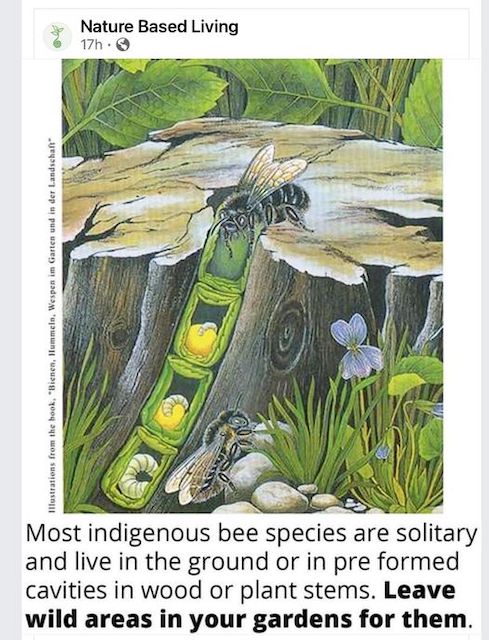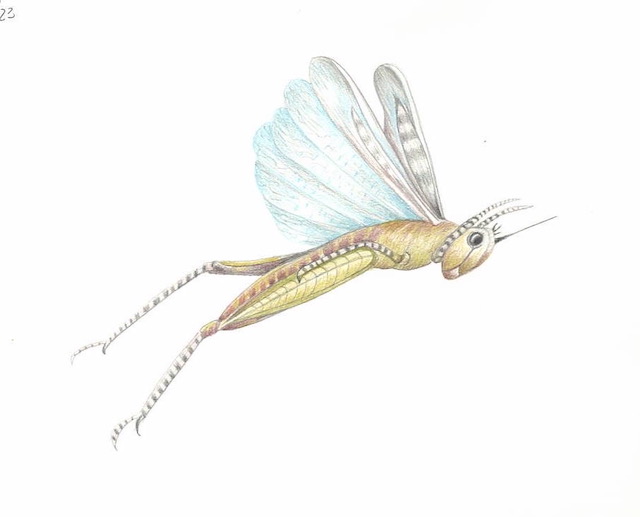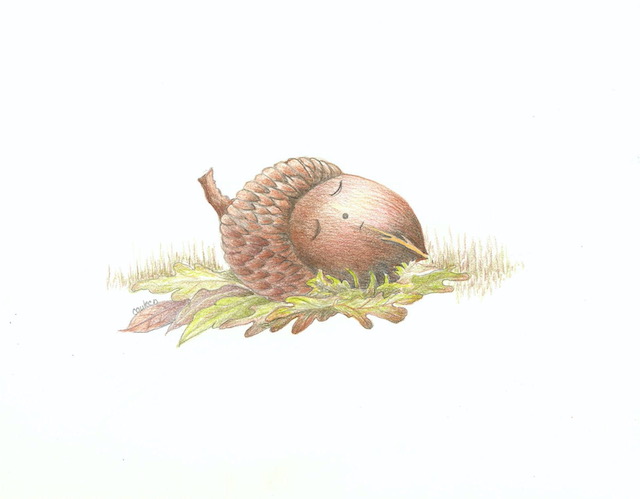| Back to Back Issues Page |
 |
|
Garden Bliss & Blunder, Issue #041 October 08, 2024 |
October Love...
“Ah, September! You are the doorway to the season that awakens my soul... but I must confess that I love you only because you are a prelude to my beloved October.” Peggy Toney Horton
leaf sketch- Cauleen Viscoff
Nesting Bees...Leaving spent stems of perennials is a good thing, right?Well, not all stems are best for nesting bees. For example, Joe Pye Weed is too wide ...but Goldenrod and Monarda are narrower and just right. Other cavity-nest makers prefer dead wood, or holes already made by other insects… so leave stems, cutting them back at random heights.
credit: Heather Holm pollinators of native plants
Cut stems in varying lengths and leave standing. Take any extras and place in pot, leaving it on its side for a wee insect hotel.
credit: Heather Holm pollinators of native plants Leave your leaf litter on beds for bees and other insects to overwinter…. if you don’t have any, your neighbours will….We don't have any sugar maple trees so we help our neighbours rake theirs and bring them to our flower beds.
Beauty and Beasts...Of course, wherever there is beauty, there are beasts or all types. Grasshoppers, crickets, cicadas, beetles and butterflies - the good, the bad and the downright adorably ugly.
Flying Grasshopper Sketch-Cauleen Viscoff ...it’s really about something called Mutualism… where one species gets, gives and/or receives from another, ensuring or sharing survival of yet another. It’s more complicated than that but here it is in a nutshell: The GRASSHOPPER benefits humans and the ecosystem by helping plant decomposition and regrowth, creating a balance between types of plants that thrive. CRICKETS are scavengers and not picky eaters who eat plant and animal matter even if rotting or decaying . CICADAS will actually prune out weak branches of a tree where they lay eggs, making that branch wither and die - trees save energy by not dealing with a weak branch. When the Cicadas die, their bodies decay and release nutrients into the soil around the tree. BEETLES feed on and break down, dead or decaying animals, leaf litter and even some crop pests BUTTERFLIES pollinate plants that produce crops ensuring diversity of native plants So, squish the really annoying ones if you must - but leave the rest to do their jobs and help to keep that circle going.. Planting Bulbs...
It's the best time to plant spring blooming bulbs. Plant Daffodils now and Tulips up until the ground freezes.... Bury them so deep (8-12 inches) you can dig in other plants on top without slicing the bulbs when you do...
See more at the link below.
Tulip bulb sketch - Cauleen Viscoff Fall Tree Care...Fall is a great time to plant trees and shrubs, but there are other things you should know in taking care of the trees you have. Dr. Bonnie Lee Appleton , a professor of horticulture at Virginia Tech University in Blacksburg says there are 4 things that need to “fall” under tree and shrub care…things to “un-do” .. she calls it “un-planting”… 1 - Un-stake (untie) 2 - Un-wrap 3 - Un-mulch 4 - Un-bind UN-STAKE A newly planted tree only needs to be staked if it cannot stand upright by itself (or needs protection from wind or people. If it needs staking, a year is plenty. if its roots cannot hold it up after a year, there may be another problem - poor soil or poor roots: staking will not fix this. Planted without stakes, trees develop trunk girth faster and stronger and able to stand up straight when buffeted by wind… even staked trees should never be held rigidly in place. UN-TIE trees so the tying material does not damage the bark (it restricts water and nutrients moving up the trunk), declining growth and creating a possible soft or weak spot that could later break. Remove labels or tags that can be absorbed by growth. UN-WRAP Take off any protection from the trunk when planted. This is unnecessary except in striations like protecting it at digging or shipping time and sometimes used for heat protection if trees are planted in paved areas. The wrap can also rot the bark, and cause trunk’s breathing pores to enlarge making entrances for insect and disease problems. Sometimes a trunk needs protection from machinery, animal feeding or vandalism with a metal or plastic guard which should be loose: not touching the bark. UN-MULCH Pull back the mulch about 4 inches away from the trunk as it can promote bark decay, disease or insect issues. More than 3 or 4 inches deep of mulch can make a cozy home for voles or other critters to munch on the softened bark. The root flare should be at the soil’s surface… if not, pull away the soil to reveal it. UN-BIND All root balling materials like natural or synthetic burlap, hemp or synthetic ropes, as much of the wire baskets as possible, plastic sleeves or pots. They restrict root growth and development. Even those so-called ‘plantable’ pots will not biodegrade fast enough and their fibres soak up the moisture before it gets to the roots.
May not be a "Mast" year for nuts...
The term "MAST" refers to the fruit/nut production of any forest tree or shrub. A “mast year” is when the trees or shrubs produce far more fruit or nuts than usual. These years occur irregularly and vary by species, approximately every 3 to 5 years in most oak species. The full explanation of the phenomenon of mast years remains a mystery, but there are a number of interesting facts and theories regarding these irregular, but extraordinarily productive years. A single oak can produce as many as 10,000 acorns in a mast year! The enormous amount of energy needed to produce these acorns means little regular growth in the tree for that year. Growth will resume its normal course in the following year when few or no acorns are produced. TORONTO.MASTER.GARDENERS.CA Sunflowers reign...I love seeing fields of sunflowers on a glorious sunny day.... even small stands of them, big or small along roadsides or ditches, in "formal" gardens tucked along a fence, or in meadow gardens. They radiate happiness for us who see them and those who fill their feathered tummies for our long winters. How can we not smile when we see them. Plant one... two or twenty two.... the squirrels plant lots of them because our neighbours put sunflower seeds in their feeders... yay
Sunflower sketch - Cauleen Viscoff (from a photo by Nancy Waldock) Time to remember...
Dying leaf sketch - Cauleen Viscoff Until Next time...Let the little sleeping acorns lie - there might not be many.
Lucy says...Take a little holiday to see your family.....stay in a fancy hotel
Have a bite of lunch in the dining room and smile at everyone.
Ride when you can - you meet the best people on the elevator.
...and in the antique shop
And save time for a latte and a 'pup cup'. Get your own chair so you can see and be seen.
Best of all? Hallowe'en !They think I am ready....but I am NOT... I do not like Hallowe'en so we go to our friend's house and hide in the back room, watching the telly, having yummy treats until it's all over.
garden-journals.html planting-roses.html planting-trees.html Back Issues for Garden Bliss & Blunder
|
| Back to Back Issues Page |

























